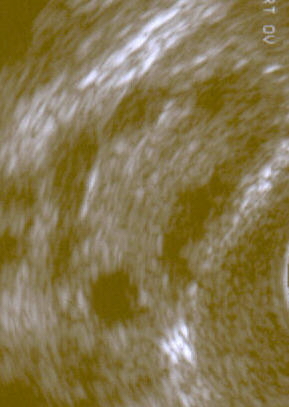వాడుకరి:Mr. Ibrahem/పాలీసిస్టిక్ అండాశయ వ్యాధి (పీసీఓడీ)
స్వరూపం
| పాలిసిస్టిక్ ఓవరీ సిండ్రోమ్ | |
|---|---|
| ఇతర పేర్లుః హైపరాండ్రోజెనిక్ అనోవులేషన్ (HHA) పాలిసిస్టిక్ అండాశయ వ్యాధి, స్టెయిన్-లెవెంథల్ సిండ్రోమ్ [1][2] | |

| |
| అల్ట్రాసౌండ్ చిత్రం చూపబడిన పాలిసిస్టిక్ అండాశయం. | |
| ప్రత్యేకతలు. | గైనకాలజీ |
| లక్షణాలు | క్రమరహిత ఋతుస్రావం, భారీ పీరియడ్స్, అధిక జుట్టు, మోటిమలు, కటి నొప్పి, గర్భవతి పొందడంలో ఇబ్బంది, మందపాటి, ముదురు, వెల్వెట్ చర్మం [3] |
| సమస్యలు. | టైప్ 2 డయాబెటిస్, ఊబకాయం, అబ్స్ట్రక్టివ్ స్లీప్ అప్నియా, గుండె జబ్బులు, మానసిక రుగ్మతలు, ఎండోమెట్రియల్ క్యాన్సర్ [4] |
| వ్యవధి | దీర్ఘకాలిక [5] |
| కారణాలు | జన్యు మరియు పర్యావరణ కారకాలు [6][7] |
| ప్రమాద కారకాలు | ఊబకాయం, తగినంత వ్యాయామం లేకపోవడం, కుటుంబ చరిత్ర [8] |
| రోగనిర్ధారణ పద్ధతి | అండోత్సర్గము, అధిక ఆండ్రోజెన్ స్థాయిలు, అండాశయ తిత్తులు ఆధారంగా [4] |
| భేదాత్మక రోగ నిర్ధారణ | అడ్రినల్ హైపర్ప్లాసియా, హైపోథైరాయిడిజం, అధిక రక్త స్థాయిలు ప్రోలాక్టిన్ [9] |
| చికిత్స | బరువు తగ్గడం, వ్యాయామం [10][11] |
| మందులు | జనన నియంత్రణ మాత్రలు, మెట్ఫార్మిన్, యాంటి-ఆండ్రోజెన్లు [12] |
| ఫ్రీక్వెన్సీ | పిల్లలను కనే వయస్సులో ఉన్న స్త్రీలలో 2% నుండి 20% వరకు [8][13] |
- ↑ Kollmann M, Martins WP, Raine-Fenning N (2014). "Terms and thresholds for the ultrasound evaluation of the ovaries in women with hyperandrogenic anovulation". Hum. Reprod. Update. 20 (3): 463–4. doi:10.1093/humupd/dmu005. PMID 24516084.
- ↑ "USMLE-Rx".
- ↑ "What are the symptoms of PCOS?" (05/23/2013). National Institute of Child Health and Human Development (NICHD). Archived from the original on 3 March 2015. Retrieved 13 March 2015.
- ↑ 4.0 4.1 "Polycystic Ovary Syndrome (PCOS): Condition Information". National Institute of Child Health and Human Development. January 31, 2017. Archived from the original on 22 October 2018. Retrieved 19 November 2018.
- ↑ "Is there a cure for PCOS?". US Department of Health and Human Services, National Institutes of Health. 2013-05-23. Archived from the original on 5 April 2015. Retrieved 13 March 2015.
- ↑ De Leo V, Musacchio MC, Cappelli V, Massaro MG, Morgante G, Petraglia F (2016). "Genetic, hormonal and metabolic aspects of PCOS: an update". Reproductive Biology and Endocrinology (Review). 14 (1): 38. doi:10.1186/s12958-016-0173-x. PMC 4947298. PMID 27423183.
{{cite journal}}: CS1 maint: unflagged free DOI (link) - ↑ Diamanti-Kandarakis E, Kandarakis H (2006). "The role of genes and environment in the etiology of PCOS". Endocrine. 30 (1): 19–26. doi:10.1385/ENDO:30:1:19. PMID 17185788.
- ↑ 8.0 8.1 "How many people are affected or at risk for PCOS?". Eunice Kennedy Shriver National Institute of Child Health and Human Development. 2013-05-23. Archived from the original on 4 March 2015. Retrieved 13 March 2015.
- ↑ "How do health care providers diagnose PCOS?". Eunice Kennedy Shriver National Institute of Child Health and Human Development. 2013-05-23. Archived from the original on 2 April 2015. Retrieved 13 March 2015.
- ↑ Mortada R, Williams T (2015). "Metabolic Syndrome: Polycystic Ovary Syndrome". FP Essentials (Review). 435: 30–42. PMID 26280343.
- ↑ Giallauria F, Palomba S, Vigorito C, Tafuri MG, Colao A, Lombardi G, Orio F (2009). "Androgens in polycystic ovary syndrome: the role of exercise and diet". Seminars in Reproductive Medicine (Review). 27 (4): 306–15. doi:10.1055/s-0029-1225258. PMID 19530064.
- ↑ National Institutes of Health (NIH) (2014-07-14). "Treatments to Relieve Symptoms of PCOS". Archived from the original on 2 April 2015. Retrieved 13 March 2015.
- ↑ editor, Lubna Pal (2013). "Diagnostic Criteria and Epidemiology of PCOS". Polycystic Ovary Syndrome Current and Emerging Concepts. Dordrecht: Springer. p. 7. ISBN 9781461483946. Archived from the original on 2017-09-10.
{{cite book}}:|last1=has generic name (help)
